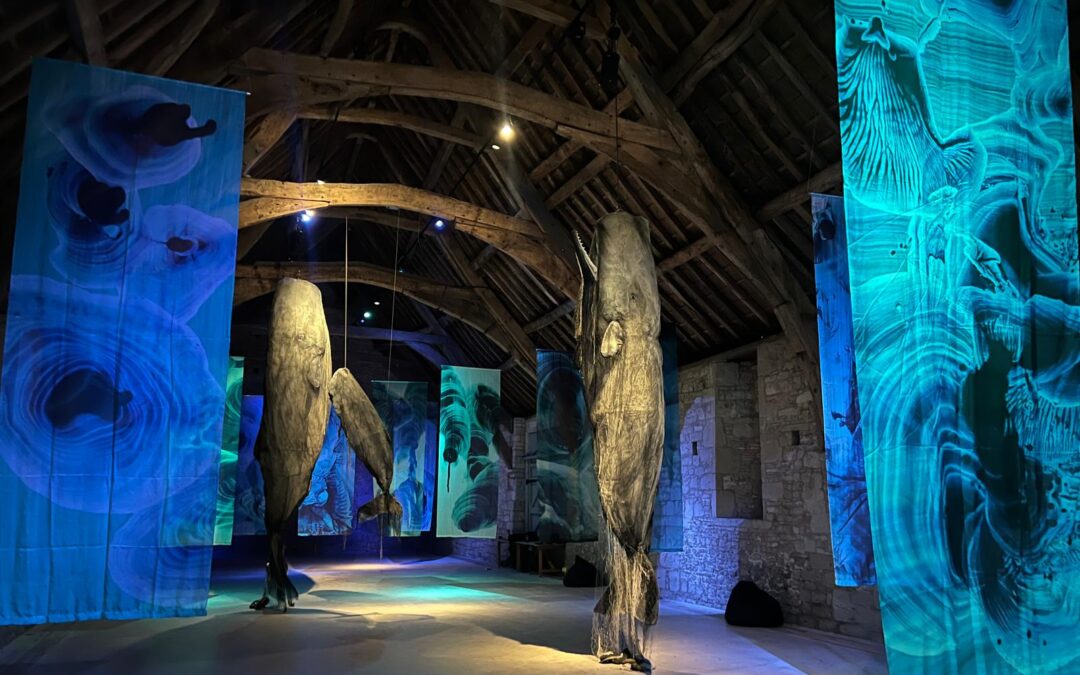At Messums West, a quiet revolution in art and environmentalism is happening. The latest exhibition by British sculptor Tessa Campbell Fraser is part of Messums’ Active Environmentalism series, grounded in the idea that understanding drives action. With her breathtaking sculptures of sperm whales, Fraser merges art with environmental advocacy, creating an immersive experience that delves into interspecies communication, climate impact, and our relationship with nature.

The highlight of Fraser’s work is a set of three monumental whale sculptures suspended from the roof of Messums’ tithe barn, their scale and structure echoing the barn’s open timbers and ceiling beams, which resemble the hull of a large ship. This setting evokes the haunting legacy of industrial whaling, a practice that once drove sperm whales nearly to extinction. Through her art, Fraser invites viewers to step into the world of the whale and consider humanity’s indelible impact on the environment.
A defining element of Fraser’s work is her choice of sustainable, natural, and repurposed materials. Among these, recycled ghost netting and silk chiffon stand out, lending an ethereal, almost translucent quality to her sculptures. Silk, often used in digital prints and as a medium for commissioned works, adds a tactile softness to these mammoth sculptures, emphasizing the gentle presence of creatures that are, despite their size, deeply vulnerable to human influence. Fraser’s technique combines this silk chiffon with recycled paper, latex, and synthetic materials made with minimal water, forging a unique artistic language that speaks to both resilience and fragility.

Fraser’s inspiration extends beyond the art itself; she’s deeply influenced by the scientific study of whale communication. Her research delved into Project CETI, a pioneering project in Dominica that explores whale communication through the recording of ‘coda-clicks’—distinctive sounds that whales use to communicate. This research, which has already identified 23 unique patterns of whale ‘coda-clicks’ and dialects, hints at the possibility of decoding whale language. Fraser sees a future where artificial intelligence could translate these sounds, potentially bridging a vast gap in interspecies understanding. Her sculptures thus capture not only the physicality of these majestic beings but also an imagined dialogue, a silent but potent communication between species.
Fraser’s journey into this world of whales was deeply personal. Reflecting on an experience swimming with a pod of female sperm whales in Dominica, she describes feeling “part of their clan,” an interspecies bond that transcended sound and sight. For Fraser, this encounter stirred an emotional resonance that has shaped her art: “To exist in this world, peacefully and fulfilled, I would do well to listen to this ancient tongue with its truly primeval message,” she recalls, adding, “this world is uniquely special and worth saving.”
In the sculptures at Messums, the transparency of ghost netting embodies this message of ephemerality. Fraser hopes the viewer recognizes that without urgent environmental action, these “great beasts” may become nothing more than “ghosts” to future generations. Rising sea temperatures, one consequence of unchecked global warming, threaten to destabilize marine ecosystems, placing whales and other sea creatures at severe risk.
Furthering her exploration of communication, Fraser devised a Victorian-inspired eidophone to visually interpret the vibrations of whale coda clicks. By capturing these clicks and translating them onto transparent paper, she invites viewers to ponder the elusive nature of conversation itself—a concept further accentuated by mirrors that float in space, mimicking the transitory nature of spoken words. Her collaboration with a music technician even creates a two-way communication, allowing viewers to “speak” back to the whales, symbolizing our shared existence on this planet.

Following its installation at Messums West, the exhibition will travel to Winchester Cathedral as part of the 250th anniversary celebrations for Jane Austen’s birth. This new venue aligns with the Cathedral’s ‘Festival of the Word,’ creating a fitting environment for a discussion of language and connection that transcends species.
Through the ephemeral beauty of silk, digital prints, and her commitment to sustainable materials, Tessa Campbell Fraser’s work does more than captivate—it challenges us to see the interconnectedness of life, the urgency of action, and the power of communication without words. Her sculptures remind us of the silent giants beneath the waves, whose futures are inextricably linked with our own.

